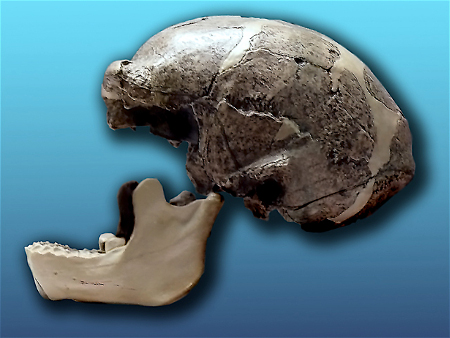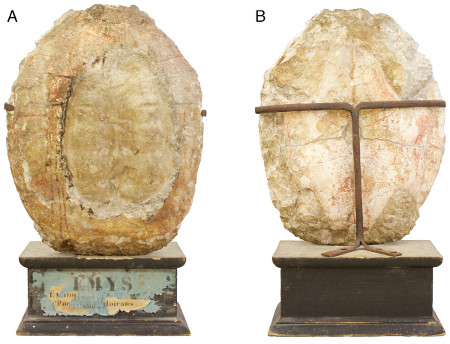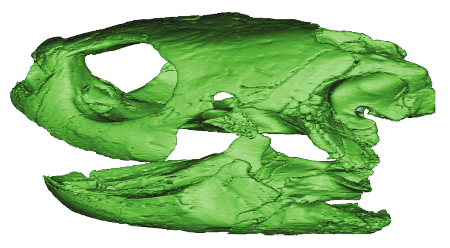Turtles Lost and Turtles Found
Science is built upon repeatability, but this means different things in different fields. For instance, a chemist in one lab should be able to follow the procedures of another lab and get the same results. In a historical science like paleontology, repeatability depends in part upon being able to restudy previously published fossils in order to verify and expand upon previous observations. Nowadays, museums are the custodians of these irreplaceable specimens. But what happens when a fossil goes missing?

Sadly, the disappearance of fossils is not totally unheard of. This can happen in wartime (as in the case of the sail-backed dinosaur Spinosaurus or with the fossils of “Peking Man”), by outright theft, or if a privately owned fossil was published upon and then later lost after the death of the owner. The published descriptions remain, of course, but they cannot be verified (e.g., if there is a question on what is reconstructed versus what is real bone), nor can the fossil be reprepared or restudied using “modern” techniques (such as CT scans, geochemistry, or histology). Science always suffers as a result.
Sometimes, paleontologists get a second chance. Let’s follow the twisted tale of a Jurassic turtle for one such case.
Way back in 1857–two years before Charles Darwin published On the Origin of Species–Swiss paleontologists François Jules Pictet de la Rive and Aloïs Humbert named a new species of extinct turtle, Emys etalloni. The fossil consisted of a shell (carapace and plastron, in the technical terminology) collected in the Jura Mountains of eastern France, from rocks now dated to around 150 million years old. That much is straightforward, but from here the story gets tangled up in church politics.

The fossil of Emys etalloni was collected by a French priest, who passed it along to another priest (in fact, the vicar general of the Saint-Claude diocese, Joseph Célestin Girod), who in turn let paleontologists Pictet and Humbert study the fossil. Girod’s superior, Bishop Mabile, helpfully offered to turn the fossil over to a local scientific society, and from there the specimen briefly ended up in the Natural History Museum of Besançon. This apparently didn’t please Vicar Girod, because he claimed that he never agreed to part ownership with the specimen. As a result, the fossil was returned to Girod, and then lost to the mists of history after he passed into the great beyond in 1863.
The original description remained in the scientific literature, and a few plaster replicas of variable quality were scattered across museums in France and Switzerland. Emys etalloni was later moved into the genus Plesiochelys, but any rigorous study of the original fossil was severely limited. This was particularly problematic, because the identity and relationships of Jurassic-aged turtles from Europe are on the messy side. Depending upon which article you read, Plesiochelys etalloni was the same as some other species or its own species. In fact, up to six other turtle species had been lumped in with P. etalloni. Some more recently discovered fossils were assigned to P. etalloni outright, too. But, were they all really the same thing as the lost French turtle? Subtle textures and markings on the shell that were necessary to resolve the issue couldn’t be confirmed from the published illustrations, and plaster replicas didn’t help either. In the end, the real fossil was needed to settle the score.
The problem has particular relevance to paleontologists because turtles like Plesiochelys branched off near the origin of modern cryptodire turtles (the most common group of turtles, including everything from your typical pond turtle to the giant Galapagos tortoises), and are thus important for tracing turtle evolution. Although more recently discovered fossils in some ways made up for the missing fossil, which name went to which fossil was pretty nebulous. There was no way to know for sure without the original fossil of Plesiochelys etalloni!
In the worst case, perhaps the fossil shell had been thrown away after Vicar Girod’s death (after all, a heavy rock isn’t the most logical thing to keep). Somewhat miraculously, this wasn’t the case. It turned out that Vicar Girod sold the fossil to a collector, and the fossil stayed in this collector’s family for over 100 years. Perhaps wanting to properly dispose of a weighty heirloom (we can speculate), the family donated their inheritance to Musée d’archéologie du Jura in Lons-le-Saunier, France, back in 1994. Twenty years later, paleontologists Jérémy Anquetin, Sylvie Deschamps, and Julien Claude recognized the specimen in the museum collection. Finally, they were able to redescribe the fossil in a recently published article in the open access journal PeerJ [full disclosure: I was the editor who handled their paper].

With the fossil in hand, Anquetin and colleagues answered some long-standing questions about Plesiochelys etalloni–most importantly, confirming its distinct identity. Of course, a thorough redescription and refiguring of the specimen led the way. Scientists who can’t visit the specimen in person now benefit from clear color figures and measurements. On top of this, the research team verified that at least three other previously named species (P. langii, P. sanctaeverenae, and P. solodurensis) were the same thing as P. etalloni. This is a critical finding, because specimens of these other “species” had skulls with them, which the recently rediscovered turtle did not. Skulls are important for unraveling fossil turtle relationships and behavior, so being able to more confidently match skulls and shells across the board is really nice!

From the seas of the Jurassic to the ecclesiastical politics of 19th century France to the digital pages of 21st century journals, Plesiochelys has quite a story to tell. With its original fossil safely (and hopefully permanently) in a museum, the next chapter finally can be written.
Citations
Anquetin J, Deschamps S, Claude J. 2014. The rediscovery and redescription of the holotype of the Late Jurassic turtle Plesiochelys etalloni. PeerJ 2:e258 http://dx.doi.org/10.7717/peerj.258
Carabajal AP, Sterli J, Müller J, Hilger A. 2013. Neuroanatomy of the Marine Jurassic Turtle Plesiochelys etalloni (Testudinata, Plesiochelyidae). PLoS ONE 8(7): e69264. doi:10.1371/journal.pone.0069264
Pictet F-J, Humbert A. 1857. Description d’une émyde nouvelle (Emys etalloni) du terrain jurassique supérieur des environs de St-Claude. In: Pictet F-J, ed. Matériaux pour la paléontologie suisse. Première série. Genève: J. Kessmann. 1-10 [freely available via Google Books]
Above: 3D scan of Plesiochelys etalloni, from Anquetin et al. 2014. CC-BY.
